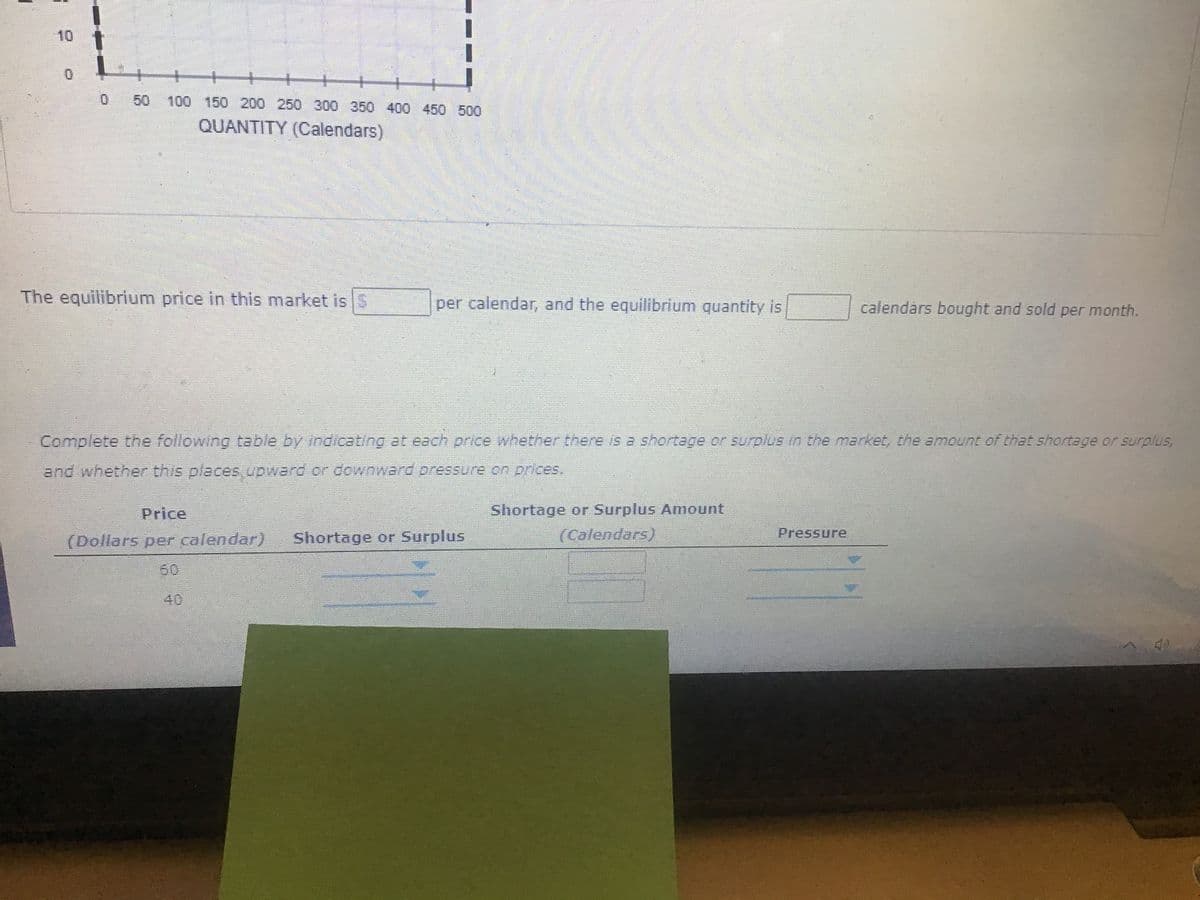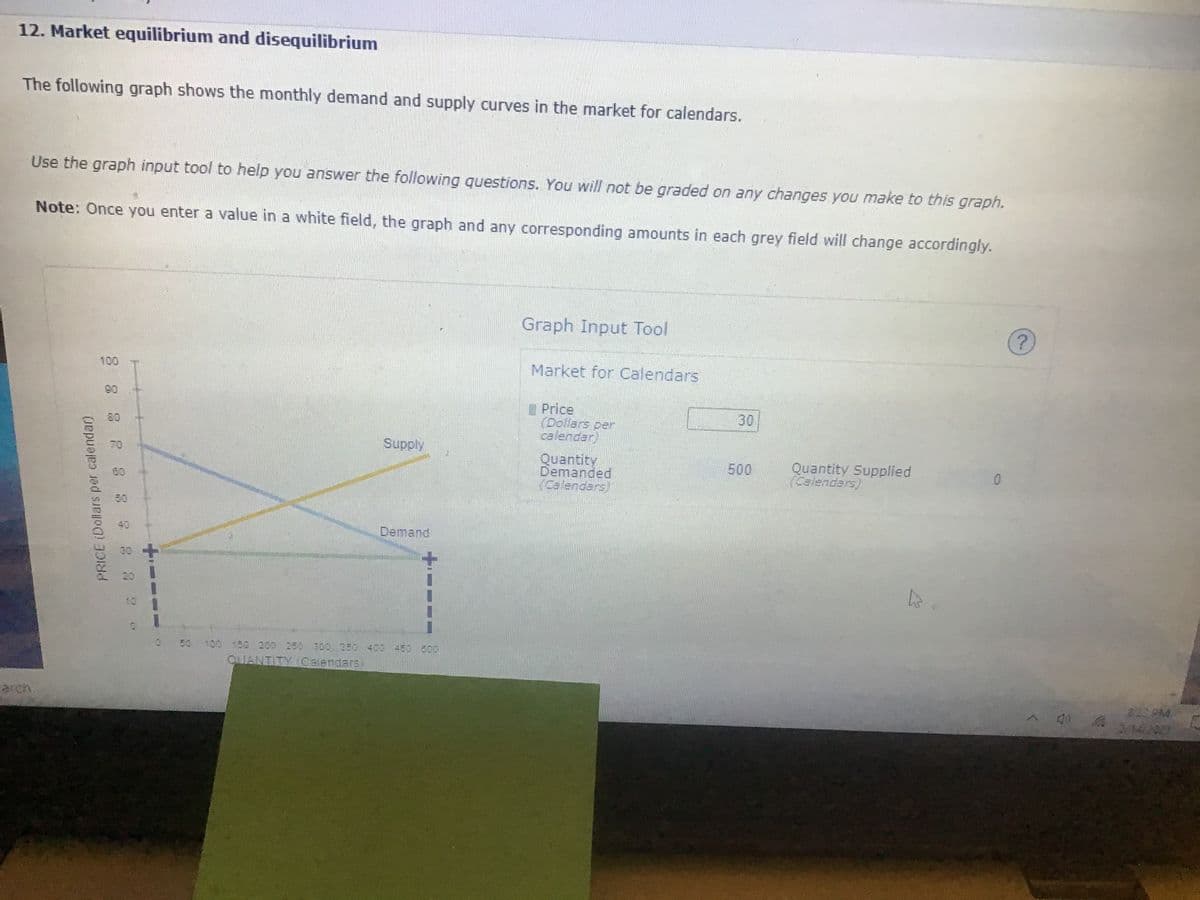Complete the following table by indicating at each price whether there is a shortage or surplus in the market, the amount of that shor and whether this places upward or downward pressure on prices. Price Shortage or Surplus Amount (Calendars) Pressure (Dollars per calendar) Shortage or Surplus 60 40
Complete the following table by indicating at each price whether there is a shortage or surplus in the market, the amount of that shor and whether this places upward or downward pressure on prices. Price Shortage or Surplus Amount (Calendars) Pressure (Dollars per calendar) Shortage or Surplus 60 40
Brief Principles of Macroeconomics (MindTap Course List)
8th Edition
ISBN:9781337091985
Author:N. Gregory Mankiw
Publisher:N. Gregory Mankiw
Chapter4: The Market Forces Of Supply And Demand
Section: Chapter Questions
Problem 3PA: Consider the market for minivans. For each of the events listed here, identify which of the...
Related questions
Question
Pressure is it downward or upward

Transcribed Image Text:10
+
50 100 150 200 250 300 350 400 450 500
QUANTITY (Calendars)
The equilibrium price in this market is S
per calendar, and the equilibrium quantity is
calendars bought and sold per month.
Complete the following table by indicating at each price whether there is a shortage or surplus in the market, the amount of that shortage or surplus,
and whether this places upward or downward pressure on prices.
Price
Shortage or Surplus Amount
(Dollars per calendar)
Shortage or Surplus
(Calendars)
Pressure
60
40
40

Transcribed Image Text:12. Market equilibrium and disequilibrium
The following graph shows the monthly demand and supply curves in the market for calendars.
Use the graph input tool to help you answer the following questions. You will not be graded on any changes you make to this graph.
Note: Once you enter a value in a white field, the graph and any corresponding amounts in each grey field will change accordingly.
Graph Input Tool
100
Market for Calendars
90
Price
(Dollars per
calendar
30
Supply
Quantity
Demanded
(Calendars)
Quantity Supplied
Calendars)
500
80
50
40
Demand
100 150 200 250 300 350 400 450 800
OIANTITY Calendars
803 PM
arch.
PRICE (Dollars per calendar)
Expert Solution
This question has been solved!
Explore an expertly crafted, step-by-step solution for a thorough understanding of key concepts.
This is a popular solution!
Trending now
This is a popular solution!
Step by step
Solved in 2 steps

Knowledge Booster
Learn more about
Need a deep-dive on the concept behind this application? Look no further. Learn more about this topic, economics and related others by exploring similar questions and additional content below.Recommended textbooks for you

Brief Principles of Macroeconomics (MindTap Cours…
Economics
ISBN:
9781337091985
Author:
N. Gregory Mankiw
Publisher:
Cengage Learning

Essentials of Economics (MindTap Course List)
Economics
ISBN:
9781337091992
Author:
N. Gregory Mankiw
Publisher:
Cengage Learning


Brief Principles of Macroeconomics (MindTap Cours…
Economics
ISBN:
9781337091985
Author:
N. Gregory Mankiw
Publisher:
Cengage Learning

Essentials of Economics (MindTap Course List)
Economics
ISBN:
9781337091992
Author:
N. Gregory Mankiw
Publisher:
Cengage Learning


Principles of Macroeconomics (MindTap Course List)
Economics
ISBN:
9781285165912
Author:
N. Gregory Mankiw
Publisher:
Cengage Learning